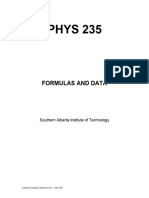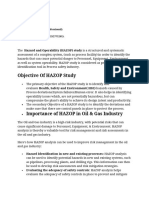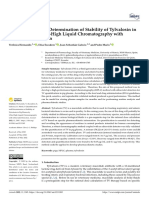Auto Ignition Temperature.
Auto Ignition Temperature.
Uploaded by
MANOJ KUMARCopyright:
Available Formats
Auto Ignition Temperature.
Auto Ignition Temperature.
Uploaded by
MANOJ KUMARCopyright
Available Formats
Share this document
Did you find this document useful?
Is this content inappropriate?
Copyright:
Available Formats
Auto Ignition Temperature.
Auto Ignition Temperature.
Uploaded by
MANOJ KUMARCopyright:
Available Formats
Auto Ignition Temperature.
Manoj Kumar( HSE Professional)
( manojkumarkameshwarsingh@gmail.com / manojkumarhiramunidevi@gmail.com / +91-
8252771261).
Fire Science is a life and property saving science. From Harappa civilization, human beings
knows the science. Manmade hazards and its removal is written in vedic literature.
Auto Ignition Temperature
The Auto-Ignition Temperature - or the minimum temperature required to ignite a gas or vapor in
air without a spark or flame being present - are indicated for some common fuels below:
Flammable Substance Temp (Deg C) Temp (Deg F)
Acetaldehyde 175 347
Acetone 465 869
Acetylene 305 581
Anthracite - glow point 600 1112
Benzene 560 1040
Bituminous coal 454 850
Butane 420 788
Carbon 700 1292
Carbon - bi sulfide 149 300
Carbon monoxide 609 1128
Charcoal 349 660
Coal-tar oil 580 1076
Coke 700 1292
Cyclohexane 245 473
Diethyl ether 160 320
Ethane 515 859
Ethylene 490 914
Ehtyl Alcohol 365 689
Fuel Oil No.1 210 410
Fuel Oil No.2 256 494
Fuel Oil No.4 262 505
Heavy hydrocarbons 750 1382
Hydrogen 500 932
Gas oil 336 637
Gasoline 280 536
Gun Cotton 221 430
Kerosene 295 563
Isobutane 462 864
Isopentane 420 788
Isopropyl Alcohol 399 750
Light gas 600 1112
Light hydrocarbons 650 1202
Lignite - glow point 562 979
Methane (Natural Gas) 580 1076
Methyl Alcohol 385 725
Naphtha 550 1022
Neohexane 425 797
Neopentane 450 842
Nitro-glycerine 254 490
n-Butane 405 761
n-Heptane 215 419
n-Hexane 225 437
n-Octane 220 428
n-Pentane 260 500
n-Pentene 298 569
Oak Wood - dry 482 900
Peat 227 400
Petroleum 400 752
Pine Wood - dry 427 800
Phosphorous, amorphous 260 500
Phospho's, transparent 49 120
Propane 480 842
Propylene 458 856
p-Xylene 530 986
Rifle Powder 288 550
Toluene 530 986
Semi anthracite coal 400 752
Semi bituminous coal 527 980
Styrene 490 914
Sulphur 243 470
Wood 300 572
Xylene 463 867
The flammable (explosive) range is the range of a gas or vapor concentration that will burn or
explode if an ignition source is introduced. Limiting concentrations are commonly called the
lower explosive or flammable limit (LEL/LFL) and the upper explosive or flammable limit
(UEL/UFL).
Below the explosive or flammable limit the mixture is too lean (diluted) to burn. Above the upper
explosive or flammable limit the mixture is too rich (saturated) to burn. The Auto-Ignition
Temperature is not the same as Flash Point - The Flash Point indicates how easy a chemical may
burn.
You might also like
- Fuels and Chemicals - Auto Ignition TemperaturesDocument5 pagesFuels and Chemicals - Auto Ignition TemperaturesyoesseoyNo ratings yet
- Flashpoint of FuelsDocument5 pagesFlashpoint of FuelsKartheek ChowNo ratings yet
- Protection Concepts: Dsear & Atex 137Document1 pageProtection Concepts: Dsear & Atex 137Paulo CostaNo ratings yet
- CV of Common Gases PDFDocument1 pageCV of Common Gases PDFhk168No ratings yet
- ATEX Labeling - TamesonDocument1 pageATEX Labeling - TamesongalamandraNo ratings yet
- DensityDocument3 pagesDensityRocky BirNo ratings yet
- Dron Wallchart 2011 07 09 11 Bleed PDFDocument1 pageDron Wallchart 2011 07 09 11 Bleed PDFcosmin75100% (1)
- Puteri CalorificeDocument2 pagesPuteri CalorificeDan SabadusNo ratings yet
- كتلوج الديكسي - 240903 - 213250Document3 pagesكتلوج الديكسي - 240903 - 213250asamhalshayb301No ratings yet
- Session 2 - Explosion Protection FundamentalsDocument24 pagesSession 2 - Explosion Protection Fundamentalsdijoz85No ratings yet
- 4EE02Document3 pages4EE02trialaccountformeNo ratings yet
- Metal or Alloy Kg/cu.mDocument17 pagesMetal or Alloy Kg/cu.mElixir CabsNo ratings yet
- Chapter 05Document7 pagesChapter 05PARIXIT MAJHINo ratings yet
- HEMATRA Table-and-GraphsDocument15 pagesHEMATRA Table-and-GraphsM00NFL0WERNo ratings yet
- Atex ChartDocument1 pageAtex ChartShinoj B.c.100% (4)
- SpecificDocument1 pageSpecificTB CoNo ratings yet
- Heating Values Fuel Gases D 8Document7 pagesHeating Values Fuel Gases D 8zubair1950No ratings yet
- Me Lab 3Document71 pagesMe Lab 3JV Lopez0% (2)
- Fuel Boiling Point: 2.2 LiquidsDocument3 pagesFuel Boiling Point: 2.2 LiquidsHaries GarciaNo ratings yet
- SOLVENT INDEX - 1969 - Chemical Reactions in Solvents and MeltsDocument4 pagesSOLVENT INDEX - 1969 - Chemical Reactions in Solvents and MeltsDavid Antonio Méndez TrejoNo ratings yet
- ADC3010 AF CGA Selection ChartsDocument1 pageADC3010 AF CGA Selection ChartsSasan AbbasiNo ratings yet
- Appendix C Heat Capacities and Property Changes of FormationDocument8 pagesAppendix C Heat Capacities and Property Changes of FormationfasdfaNo ratings yet
- Rotameter Gas Factor ChartDocument1 pageRotameter Gas Factor ChartLee Liang ChenNo ratings yet
- Lubricant Recommendations PDFDocument8 pagesLubricant Recommendations PDFralphNo ratings yet
- HeatCapacity HeatOfFormationDocument4 pagesHeatCapacity HeatOfFormationAlejandra Fajardo ApoloNo ratings yet
- Carta de Conexiones CgaDocument1 pageCarta de Conexiones CgaSadot GutierrezNo ratings yet
- 1 s2.0 S174396711400021X MainDocument5 pages1 s2.0 S174396711400021X MainantjobNo ratings yet
- Cylinder Valve Connections DIN BS CGA 1Document3 pagesCylinder Valve Connections DIN BS CGA 1Ed HernandezNo ratings yet
- Fuels and Combustion1Document12 pagesFuels and Combustion1Dinesh VelNo ratings yet
- Appendix C Heat CapacitiesDocument8 pagesAppendix C Heat CapacitiesKrishNo ratings yet
- Nama Benda Massa Jenis KG/M Nama Benda Massa Jenis KG/MDocument5 pagesNama Benda Massa Jenis KG/M Nama Benda Massa Jenis KG/MWaris WarisNo ratings yet
- Appendix C ThermoDocument5 pagesAppendix C ThermoNadia khalizaNo ratings yet
- Heat Capacities of Gases in The Ideal Gas StateDocument1 pageHeat Capacities of Gases in The Ideal Gas Stateدكتور كونوهاNo ratings yet
- MatisseDocument2 pagesMatisseSimion RaphaelaNo ratings yet
- Part 49 Melting Point of Carbon Steel & Stainless SteelDocument9 pagesPart 49 Melting Point of Carbon Steel & Stainless Steelravindra_jivaniNo ratings yet
- CGA Connection ChartDocument1 pageCGA Connection ChartstaffordnathNo ratings yet
- Melting and Boiling Temperatures - Evaporation and Melting Heats common MaterialsDocument1 pageMelting and Boiling Temperatures - Evaporation and Melting Heats common MaterialsM1G4D1N0No ratings yet
- Specific Heat of Common SubstancesDocument3 pagesSpecific Heat of Common SubstanceslordvolderexNo ratings yet
- Speed of Sound in Various Media: ReferencesDocument2 pagesSpeed of Sound in Various Media: ReferencesAlejandro ZagalNo ratings yet
- Material Code Ref ListDocument21 pagesMaterial Code Ref ListObaid KhanNo ratings yet
- Combustion tableDocument2 pagesCombustion tableibrahimabdella20001No ratings yet
- Gpa Nga Out Dpcu 03-12-2019 PDFDocument1 pageGpa Nga Out Dpcu 03-12-2019 PDFFebriansatallNo ratings yet
- Density: Fuel - ρ - Specific Volume - vDocument2 pagesDensity: Fuel - ρ - Specific Volume - vAnggoro RagilNo ratings yet
- SP TableDocument1 pageSP Tableicelemon_zhouNo ratings yet
- CDB 4323 Assignment 1Document2 pagesCDB 4323 Assignment 1Muhammad AnwarNo ratings yet
- Fuels - Higher Calorific ValuesDocument4 pagesFuels - Higher Calorific ValuesPaijo TejoNo ratings yet
- Gas Melt Temperature RevisedDocument1 pageGas Melt Temperature Revisedr.raakildeNo ratings yet
- Fluorochrome TableDocument5 pagesFluorochrome TablePinoteDiegoNo ratings yet
- Flammable Gas and VapoursDocument1 pageFlammable Gas and Vapoursanais trifanNo ratings yet
- PHYS 235 Formula BookDocument8 pagesPHYS 235 Formula BookSimranjitNo ratings yet
- Calculation TKDocument2 pagesCalculation TKNguyễn Hoàng ThànhNo ratings yet
- Comm Lab FlammableDocument1 pageComm Lab Flammablewawan setiawanNo ratings yet
- Stains & IndicatorsDocument3 pagesStains & Indicatorsapi-3778887No ratings yet
- Uls DieselDocument1 pageUls DieselHUYQUYENNo ratings yet
- T.C. Forensic - Article 10 - Physical Constants For InvestigatorsDocument6 pagesT.C. Forensic - Article 10 - Physical Constants For Investigatorsecordova1No ratings yet
- Latent Heat of EvaporationDocument1 pageLatent Heat of EvaporationSaurabh GhodmodeNo ratings yet
- Search Engine.Document1 pageSearch Engine.MANOJ KUMARNo ratings yet
- Stress, Fear, And Anxiety.Document2 pagesStress, Fear, And Anxiety.MANOJ KUMARNo ratings yet
- Demolition Hazards.Document3 pagesDemolition Hazards.MANOJ KUMARNo ratings yet
- HAZOPDocument3 pagesHAZOPMANOJ KUMARNo ratings yet
- Alstom (Back Safety) .Document4 pagesAlstom (Back Safety) .MANOJ KUMARNo ratings yet
- Chapter Forty.Document5 pagesChapter Forty.MANOJ KUMARNo ratings yet
- NavaratriDocument6 pagesNavaratriMANOJ KUMARNo ratings yet
- Ancestral Family Tree or Geneology.Document9 pagesAncestral Family Tree or Geneology.MANOJ KUMARNo ratings yet
- Chapter Forty.Document9 pagesChapter Forty.MANOJ KUMARNo ratings yet
- Chapter Seven.Document8 pagesChapter Seven.MANOJ KUMARNo ratings yet
- Sale of Land and House.Document2 pagesSale of Land and House.MANOJ KUMARNo ratings yet
- PASS Method.Document2 pagesPASS Method.MANOJ KUMARNo ratings yet
- Fault Tree Analysis.Document3 pagesFault Tree Analysis.MANOJ KUMARNo ratings yet
- Beware of Damaging of Your Ears.Document4 pagesBeware of Damaging of Your Ears.MANOJ KUMARNo ratings yet
- Alstom12345-World First Aid DayDocument4 pagesAlstom12345-World First Aid DayMANOJ KUMARNo ratings yet
- Dokumen - Tips Safety Environment Fire Officer Ioshe Ranchi ProspectuspdfDocument13 pagesDokumen - Tips Safety Environment Fire Officer Ioshe Ranchi ProspectuspdfMANOJ KUMARNo ratings yet
- Lord Krishna.Document2 pagesLord Krishna.MANOJ KUMARNo ratings yet
- SchizophreniaDocument7 pagesSchizophreniaMANOJ KUMARNo ratings yet
- As 4566 FFGDocument3 pagesAs 4566 FFGMANOJ KUMARNo ratings yet
- Manoj's Coaching CentreDocument1 pageManoj's Coaching CentreMANOJ KUMARNo ratings yet
- # Iosh (MS) Version 5.0 Certified #Member:Iac, Newyork # International Qualifications From IrelandDocument5 pages# Iosh (MS) Version 5.0 Certified #Member:Iac, Newyork # International Qualifications From IrelandMANOJ KUMARNo ratings yet
- CBSE NCERT Solutions For Class 8 Science Chapter 4: Back of Chapter QuestionsDocument5 pagesCBSE NCERT Solutions For Class 8 Science Chapter 4: Back of Chapter QuestionsMubashir RazaNo ratings yet
- Oml753 SyllabusDocument1 pageOml753 Syllabusnishanth87No ratings yet
- Science 9 DLP Q2W7D1-2Document2 pagesScience 9 DLP Q2W7D1-2claire gucelaNo ratings yet
- Non-Aqueous-Titration Good OneDocument36 pagesNon-Aqueous-Titration Good OneYashwanth YashuNo ratings yet
- What Are The Essential Properties of An Ideal Refrigerant and Why Freon 12 Was BannedDocument5 pagesWhat Are The Essential Properties of An Ideal Refrigerant and Why Freon 12 Was BannedAlexander MugabeNo ratings yet
- 31 5 2 ScienceDocument27 pages31 5 2 Sciencevikrantsalve14No ratings yet
- IC 7. Hybridization CorrectionsDocument3 pagesIC 7. Hybridization Correctionscavidan20055No ratings yet
- Cytokinins-Discovery, Biosynthesis and Physiological Role: Unit 5.1Document6 pagesCytokinins-Discovery, Biosynthesis and Physiological Role: Unit 5.1RimeiaNo ratings yet
- Thermal Processing of FoodDocument23 pagesThermal Processing of FoodDharanibalan PNo ratings yet
- Full Download Peptide Synthesis and Applications 2nd Edition Knud J. Jensen (Auth.) PDFDocument84 pagesFull Download Peptide Synthesis and Applications 2nd Edition Knud J. Jensen (Auth.) PDFmajrohxheny100% (2)
- Kwik KoldDocument9 pagesKwik Koldkevin mccormacNo ratings yet
- Engineering Engineering Engineering Engineering Standard Standard Standard StandardDocument12 pagesEngineering Engineering Engineering Engineering Standard Standard Standard StandardgustavoNo ratings yet
- Calcium BLT00015 16Document2 pagesCalcium BLT00015 16Fazal RazaNo ratings yet
- Animals 12 01385 v2Document12 pagesAnimals 12 01385 v2aesorianNo ratings yet
- MM105301MM Non-Destructive Testing: Liquid Penetrant Test (LPT)Document48 pagesMM105301MM Non-Destructive Testing: Liquid Penetrant Test (LPT)Aryan AggarwalNo ratings yet
- Practical Steps To GPC Method Development March2016Document46 pagesPractical Steps To GPC Method Development March2016Edwel GutierrezNo ratings yet
- Lab Report 5Document6 pagesLab Report 5Daniel Ngenokesho WandyaNo ratings yet
- BOQ Pengadaan Material Plate & Channel Perbaikan TK 05Document1 pageBOQ Pengadaan Material Plate & Channel Perbaikan TK 05ayuna suciNo ratings yet
- Lesson 2 - ReactivityDocument15 pagesLesson 2 - ReactivityAmal ZahraNo ratings yet
- Naming Compounds 3Document1 pageNaming Compounds 3이채운No ratings yet
- ساختار لوئیسDocument2 pagesساختار لوئیسapi-3706290100% (1)
- Annex J - Concrete Pouring PermitDocument2 pagesAnnex J - Concrete Pouring PermitSymbian ToniNo ratings yet
- Week 1 BIO Learn - ExcretionDocument22 pagesWeek 1 BIO Learn - ExcretionEseel AlsammarraieNo ratings yet
- TUV-CPSIA (Phthalates-Lead-Formadehyde) ThinnerDocument4 pagesTUV-CPSIA (Phthalates-Lead-Formadehyde) ThinnerHà LêNo ratings yet
- General Chemistry 1: San Juan de Dios Educational Foundation, IncDocument3 pagesGeneral Chemistry 1: San Juan de Dios Educational Foundation, IncAyesha Faye BelarminoNo ratings yet
- Lecture 1Document67 pagesLecture 1Shaira Jane AlcantaraNo ratings yet
- Miacademy - All LessonsDocument1 pageMiacademy - All Lessonslogan.mckeownNo ratings yet
- Outline: ENVE 322 Transport Processes in Environmental EngineeringDocument10 pagesOutline: ENVE 322 Transport Processes in Environmental Engineeringcanasena072No ratings yet
- Curso Básico de AstronáuticaDocument90 pagesCurso Básico de AstronáuticaFreddy Fontalvo GonzalezNo ratings yet
- A Study of The Deactivation of Low Loading Ni:Al2O3 Steam Reforming Catalyst by TetrahydrothiopheneDocument7 pagesA Study of The Deactivation of Low Loading Ni:Al2O3 Steam Reforming Catalyst by TetrahydrothiopheneVương Duy NghiêmNo ratings yet










































































































